Directions (1-5): A number and word arrangement machine when given an input line of numbers and words rearrange them following a particular rule in each step. The following is an illustration of an input rearrangement.
Input: bread 31 63 break breach 44 breed 24 breath 51
Step I: bread 31 63 break 44 breed breath 51 breach 08
Step II: 63 break 44 breed breath 51 breach 08 bread 03
Step III: 63 breed breath 51 breach 08 bread 03 break 16
Step IV: 63 breed breach 08 bread 03 break 16 breath 05
Step V: breach 08 bread 03 break 16 breath 05 breed 18
Step VI: 08 08 04 03 11 16 08 05 04 18
Step VII: 03 04 04 05 08 08 08 11 16 18
And the step VII is the last step of the rearrangement. As per the rules followed in the above step, find out for each of the following questions the appropriate step for the given input.
Input: deaf 43 87 deal dead 54 due 23 dear 68
Q1. How many steps are required to get the final step?
(a) Six
(b) Seven
(c) Eight
(d) Nine
(e) None of these
Q2. How many elements are between ‘dead’ and ‘deal’ in the step IV of the given input?
(a) One
(b) Two
(c) Three
(d) Four
(e) None of these
Q3. Which of the following is the fourth step of the given input?
(a) 87 due dead 06 deaf 12 deal 20 dear 48
(b) 87 due deaf 12 dead 06 deal 20 dear 48
(c) 87 due dead 06 deaf 12 dear 48 deal 20
(d) 87 dead due 06 deaf 12 deal 48 dear 20
(e) None of these
Q4. How many words are between ‘06’ and ‘56’ in step V of the given input?
(a) One
(b) Two
(c) Three
(d) Four
(e) None of these
Q5. In which of the following step ‘dead 06 deaf 12’ will appear in the same sequence?
(a) Step II
(b) Step III
(c) Step IV
(d) Step V
(e) All of these
Directions (6-9): To answer the questions study the following example based on the corresponding conditions given below it.
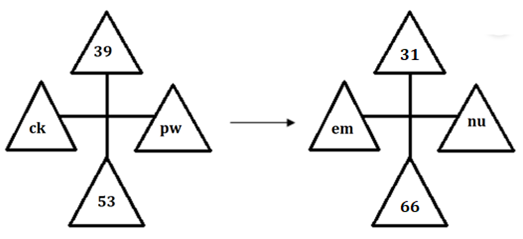
Conditions:
I. If number of vowels in English alphabetical series between the alphabets, which are in the triangle is 2 or greater than 2, then each alphabet in the triangle will be replaced by the second succeeding alphabet.
II. If number of vowels in English alphabetical series between the alphabets which are in triangle is 1, then each alphabet will be replaced by the second preceding alphabet.
III. If multiplication of both the digits in the triangle is greater than 20 then the number in the triangle will be decreased by 8.
IV. If multiplication of both the digits in the triangle is 20 or less than 20 then the number in the triangle will be increased by 13.
As per the given conditions, find the output of the given input and answer the following question:
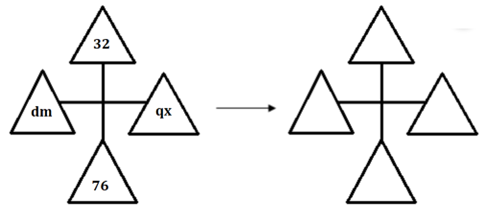
Q6. What is the sum of the digits of the greater number among the two numbers present in the output of the given input?
(a) 14
(b) 16
(c) 18
(d) 20
(e) None of these
Q7. How many vowels are present in the output of the given input?
(a) One
(b) Two
(c) Three
(d) Four
(e) None of these
Q8. How many alphabets are there (according to English alphabetical series) in between the second alphabets of both the triangles in the output of the given input?
(a) Seven
(b) Eight
(c) Six
(d) Four
(e) None of these
Q9. What is the difference between the both numbers in the output?
(a) 26
(b) 27
(c) 25
(d) 23
(e) None of these
Directions (10-12): In the question below there are three conclusions followed by four statements in the options. You have to take the four given statements to be true even if they seem to be at variance from commonly known facts and then decide which of the given statements are true disregarding the commonly known facts.
Q10. Conclusions: No Cycle is bus. Some autos are cars. Some trucks are not cycles.
(a) No cycle is auto. Some cars are cycles. Some autos are buses. All buses are trucks.
(b) All autos are buses. Some cars are not cycles. Some cycles are autos. No bus is truck.
(c) Some buses are trucks. No car is cycle. Some cycles are autos. Some auto is bus.
(d) Some cars are cycles. All cycles are autos. No auto is bus. All buses are trucks.
(e) None of these
Q11. Conclusions: Some minutes may be hours. No months are years. Some days are minutes.
(a) Some minutes are months. All months are days. Some days are years. No years are hours.
(b) Some minutes are months. No months are days. No days are years. All years are hours.
(c) No minutes are months. Some months are days. No days are years. Some years are hours.
(d) Some minutes are months. All months are days. No days are years. Some years are hours.
(e) None of these
Q12. Conclusions: No ball is red. Some shoes are black. Some bats are balls.
(a) Some bats are black. Some bats are not shoes. All balls are bats. Some black are red.
(b) All bats are black. Some bats are shoes. All balls are bats. No black is red.
(c) No bat is black. Some bats are shoes. All balls are bats. Some black are not red.
(d) Some bats are not black. No bat is shoe. All balls are bats. All black are red.
(e) None of these.
Directions (13-15): In the question below, two/ there are three conclusions followed by four statements in the options. You have to take the four given statements to be true even if they seem to be at variance from commonly known facts and then decide which of the given statements are true disregarding the commonly known facts.
Q13. Conclusions: Some shelves are boxes. Some tables are shelves. No box is chair.
(a) Some floors are not boxes. No box is shelf. Some boxes are tables. Some shelves are chairs.
(b) Some floors are boxes. Some boxes are not shelves. Some boxes are tables. All shelves are chairs.
(c) All floors are boxes. Some boxes are shelves. No box is table. All shelves are chairs.
(d) Some floors are boxes. All boxes are shelves. Some boxes are tables. No shell is chair.
(e) None of these.
Q14. Conclusions: Some fruits are oranges. All bananas being fruits is a possibility. No apple is mango.
(a) Some oranges are apples. Some apples are bananas. No apple is a fruit. No fruit is a mango.
(b) Some apples are oranges. Some apples are bananas. All bananas are fruits. No fruit is a mango.
(c) Some apples are oranges. All apples are fruits. No fruit is a mango. Some oranges are bananas.
(d) All oranges are apples. All apples are fruits. Some bananas are fruits. Some fruits are mango.
(e) None of these
Q15. Conclusions: Some black is not blue. Some blue is green is a possibility.
(a) Some blue are green. No red is black. All black are green.
(b) All blue are red. Some red is black. All black are green.
(c) No blue is red. All red is black. No black is green.
(d) No blue is red. No red is black. All black are green.
(e) None of the above
Solutions
Solution (1-5):
Step 1: First word according to the English Dictionary order moves to the extreme right end and multiplication of both digits of smallest number moves after it.
Step II: Second word according to the English Dictionary order moves to the extreme right end and multiplication of both digits of second smallest number moves after it.
Step III: Third word according to the English Dictionary order moves to the extreme right end and multiplication of both digits of third smallest number moves after it.
Step IV: Fourth word according to the English Dictionary order moves to the extreme right end and multiplication of both digits of second largest number moves after it.
Step V: Fifth word according to the English Dictionary order moves to the extreme right end and multiplication of both digits of largest number moves after it.
Step VI: Replace all the words with the numerical value of last alphabet according to the English alphabetical series.
Step VII: Arrange all the numbers in increasing order from left.
Input: deaf 43 87 deal dead 54 due 23 dear 68
Step I: deaf 43 87 deal 54 due dear 68 dead 06
Step II: 87 deal 54 due dear 68 dead 06 deaf 12
Step III: 87 due dear 68 dead 06 deaf 12 deal 20
Step IV: 87 due dead 06 deaf 12 deal 20 dear 48
Step V: dead 06 deaf 12 deal 20 dear 48 due 56
Step VI: 04 06 06 12 12 20 18 48 05 56
Step VII: 04 05 06 06 12 12 18 20 48 56
S1. Ans. (b)
S2. Ans. (c)
S3. Ans. (a)
S4. Ans. (d)
S5. Ans. (e)
Solution (6-10):
In the triangle which is in north direction, we get,
3×2 = 6,
6 < 20,
So, we apply condition IV and we get,
32 + 13 = 45.
So, 32 will be replaced by 45.
In the triangle which is in south direction, we get,
7 × 6 = 42,
42 > 20,
So, we apply condition III and we get,
76 – 8 = 68.
So, 76 will be replaced by 68.
In the triangle which is in west direction, we get,
There are two vowels (E and I) between d and m.
So, we apply condition I and we get,
d + 2 = f; m + 2 = o
So, ‘dm’ will be replaced by ‘fo’.
In the triangle which is in east direction, we get,
There is one vowel (U) between q and x.
So, we apply condition II and we get,
q – 2 = o; x – 2 = v
So, ‘qx’ will be replaced by ‘ov’.
The final output of the given input is as follows:
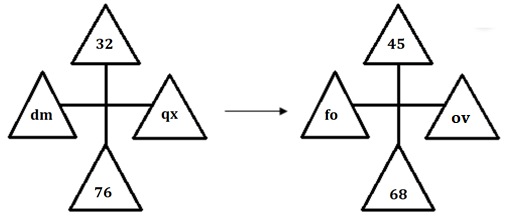
S6. Ans. (a)
S7. Ans. (b)
S8. Ans. (c)
S9. Ans. (d)
S10. Ans. (d)
Sol.

S11. Ans. (d)
Sol.

S12. Ans. (b)
Sol.

S13. Ans. (d)
Sol.
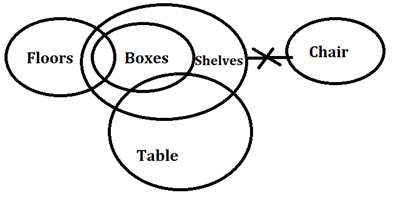
S14. Ans. (c)
Sol.

S15. Ans. (c)
Sol.



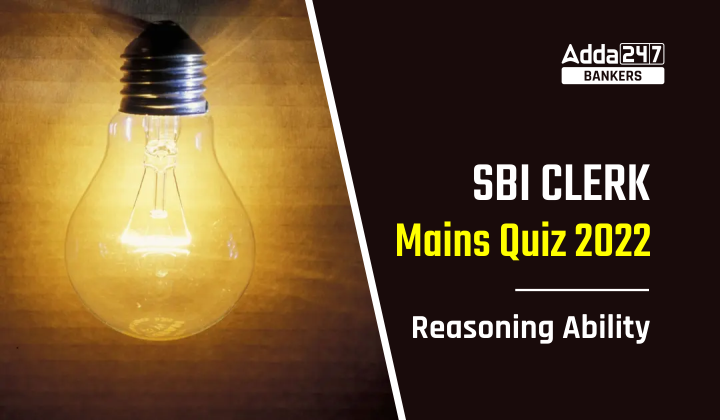


 GA Capsule for SBI Clerk Mains 2025, Dow...
GA Capsule for SBI Clerk Mains 2025, Dow...
 The Hindu Review October 2022: Download ...
The Hindu Review October 2022: Download ...
 ECGC PO Cut off 2025 Out, Check Final Cu...
ECGC PO Cut off 2025 Out, Check Final Cu...




